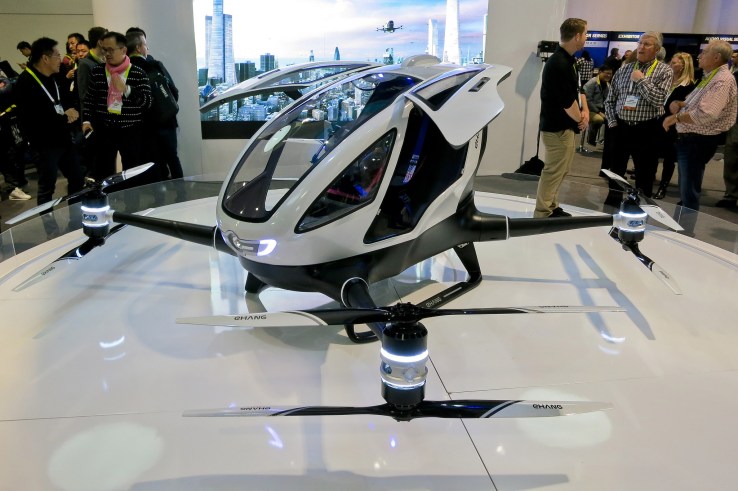
It’s 9 p.m. and you’ve finally gotten the kids in bed, leaving just enough time to prepare for tomorrow. You head into your home office and flick on the light, which also happens to be a Bluetooth speaker. The bulb reads out your schedule for the next day, and you realize you’re supposed to take a snack to your daughter’s class party.
You hop into your flying car, lift off and jet to the grocery store. Cupcakes are always a hit, but do you really want to deliver piles of pure sugar to a class of already hyperactive eight-year-olds? You pull out your phone and scan the sweets to see just how bad a sugar high they’ll cause. According to the app, the chemical makeup is even worse than you thought. Feeling charitable, you spare your daughter’s teacher a massive headache and opt for wheat crackers, instead.
If flying cars and personal assistants that live inside your light bulbs sound far-fetched, think again. The high-tech apps and devices that debuted at CES 2016 this year prove we’re living in the future. Let’s look at how these products are set to shape — or reshape — our worlds.
Sengled Voice
Sengled broke new ground in the smart light bulb industry by combining a bulb and Bluetooth wireless speaker in the new Sengled Voice. It detects fire alarms and babies’ cries and allows you to browse the Internet and check your calendar without needing your phone.
The Sengled Voice functions as a voice-controlled personal assistant, and it takes up far less space than personal home hubs like the Amazon Echo. The MiPow Playbulb is another excellent product, but Sengled pushes the envelope more than most companies. The Voice is the only smart bulb that can act as an assistant, and the company also makes bulbs that work as wireless repeaters.
Mass adoption will depend on the quality of the voice recognition software and whether the price point is accessible.
Whether the Sengled Voice takes off remains to be seen. Mass adoption will depend on the quality of the voice recognition software and whether the price point is accessible. Sengled has the potential to add upgrades to future Voice incarnations, such as a camera that turns the bulb into a baby monitor, which would give it more appeal. But as home automation accelerates, so will these types of devices.
In the same way that smartphones made independent GPS systems redundant, the Sengled Voice and other smart bulbs will eliminate the need for standalone speakers and other devices, potentially redefining the home experience.
EHang flying vehicle
Advances in piloted drone technology have just about turned science fiction into reality.EHang debuted its short-range flying vehicle at CES, and is already developing an even more advanced model.
Thanks to hobbyists buying drones in recent years, cost and technology barriers have dropped and made room for more sophisticated models. We won’t see drivers take to the skies en masse before the Federal Aviation Administration regulates this unprecedented industry, but it’s only a matter of time before more companies manufacture these cars.
EHang’s car and other flying-vehicle developers are not only paving the way for a new type of travel, but they’re also driving debates about the safety and legality of self-piloting systems. Google continues to face regulatory roadblocks in its automated-car development, and the broader industry needs to educate lawmakers and the public about the benefits of self-driving machines.
Advances in piloted drone technology have just about turned science fiction into reality.
To do that, EHang and other companies need to emphasize safety features, such as multiple emergency failovers and manual overrides in case systems crash. EHang must also incorporate advanced radar technology into its designs so the drone can avoid collisions, as well as increased battery life. The current EHang model gets 23 minutes of flying time before needing to charge, which isn’t useful outside of hobby flying.
While automated aerial vehicles won’t become commercially viable for some time, automated ground cars saw significant progress in the last year. Delphi debuted a new system at CES that enables cars to “communicate” with nearly everything around them — devices, traffic lights and even pedestrians. This kind of assisted driving technology is the next step toward fully driverless cars, which may only be a few years away.
DietSensor SCiO food scanner
The DietSensor scanner stands in a class all its own, which is likely why it won the CES Innovation Award in software and apps for 2016. It’s the first product that enables users to learn the chemical makeup of their foods by scanning them into a smartphone app.
The technology needs further development before it’s ready for the mainstream market, as it can’t yet provide data on complex items like sandwiches and burritos. But it signals the increasing power consumers will gain in understanding exactly how healthy certain foods actually are, regardless of what their manufacturers claim.The app relies on near-infrared spectroscopy to analyze the molecular components of different foods, then generates a nutritional report for users. Rémy and Astrid Bonnasse developed the concept with the Israeli company Consumer Physics as a way to help their daughter, who has Type 1 Diabetes, manage her diet. If future versions can scan more complex foods, the scanner could become a valuable tool for people with precise nutritional needs and users who simply want more information on what they eat.
Automated, integrated tools are the trends to watch for in 2016 and beyond. Smart home development, in particular, will increase as the concept becomes more common. With a look toward the future, these innovations are simplifying our lives and introducing new possibilities for how we eat, travel and manage our responsibilities.

Comments
Post a Comment